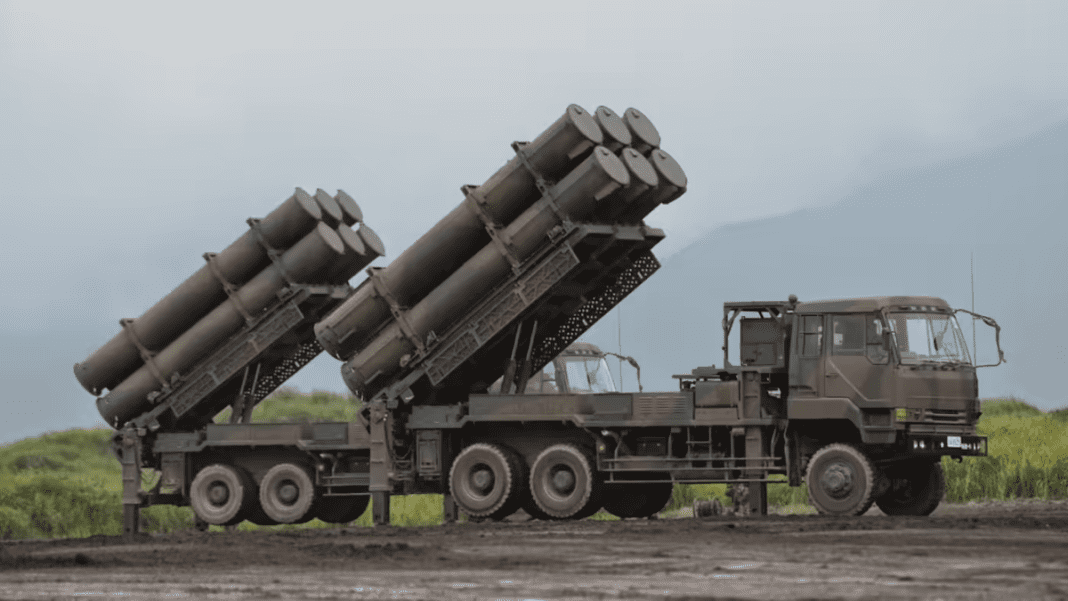Japan is getting ready to deploy long-range anti-ship missiles in Kumamoto Prefecture this fiscal year. This major defense step comes as China continues to increase its military activities near the Nansei Islands, a chain of islands in the southwest of Japan.
Japan Strengthens Defense with Powerful New Missiles
The Japanese government will deploy the improved version of the Type 12 surface-to-ship missile, made in Japan, at Camp Kengun, a base of the Ground Self-Defense Force (GSDF) in Kumamoto.
Japan’s new defense strategy includes these advanced missiles as a key element. Engineers designed them to hit targets from far away while avoiding the enemy’s attack range. This new ability is called a “standoff capability.”
The enhanced Type 12 missile can travel up to 1,000 kilometers. It can even reach China’s coastline from Japan. The older version had a much shorter range of about 200 kilometers. It was mainly used for coastal defense and close-range attacks.
While it was effective against nearby threats, the limited distance restricted Japan’s ability to respond to dangers further away. The new version significantly boosts Japan’s defensive reach and allows for greater flexibility in handling regional security challenges.
➡️ Japan warns of new nuclear threats from North Korea in explosive defense report
More Bases May Receive Missiles Soon
The Defense Ministry also plans to deploy these missiles to other bases. One of them is Camp Yufuin, another GSDF base, but the exact timing has not yet been decided. It may happen in the next fiscal year or later.
Officials are also looking at Vice Camp Katsuren in Okinawa Prefecture as a possible future location for the missile system. Okinawa is very close to the Nansei Islands and would be a strategic location for defense purposes.
Japan started mass-producing the enhanced Type 12 missile in fiscal 2023 and successfully test-fired it last year on Niijima Island, located south of Tokyo.
In 2022, the Japanese government made a significant shift in its defense strategy by officially including long-range missile capabilities in its revised national security documents.
Adding standoff missile systems like the upgraded Type 12 is a big change for Japan. It moves away from the country’s past focus on limited self-defense. This new policy shows that Japan wants stronger protection. It plans to strike threats from far away before they can attack.
Japan’s stunning Type 88 missile launch shocks Asia, sparks fresh China fears
Concerns Over Safety and Constitution
Not everyone supports the decision to deploy these long-range missiles. Some people are worried that having these powerful weapons could make Japanese military bases targets if a war breaks out. These bases could become early attack points during any conflict.
Others raise legal concerns. Japan’s Constitution, especially Article 9, limits the country’s military actions to self-defense only. Critics argue that Japan may use long-range standoff missiles in ways that go beyond simple defense and could signal a shift toward offensive capability.
Even with these concerns, the government is moving forward with the plan. It believes that this deployment is necessary to keep Japan safe from possible threats, especially in the face of China’s growing military activity near Japan’s borders.
The coming months will see the first deployment of these missiles at Camp Kengun. This marks an important step in Japan’s efforts to improve its defense systems and protect its territorial waters and islands from outside threats.
As tensions rise in the region, Japan is choosing to boost its defensive strength using technology developed within the country. The decision reflects how seriously the nation views the current security situation in East Asia.

